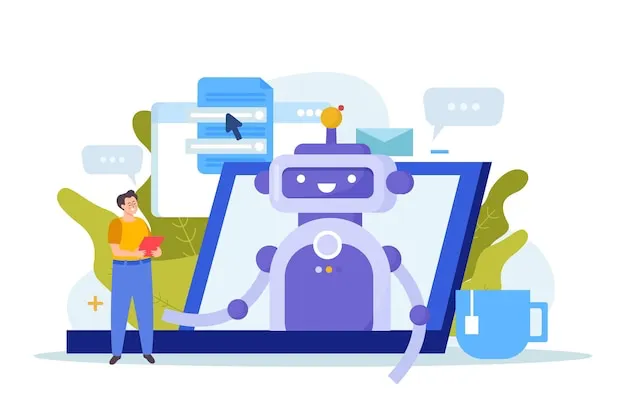
Editorial Disclaimer
This content is published for general information and editorial purposes only. It does not constitute financial, investment, or legal advice, nor should it be relied upon as such. Any mention of companies, platforms, or services does not imply endorsement or recommendation. We are not affiliated with, nor do we accept responsibility for, any third-party entities referenced. Financial markets and company circumstances can change rapidly. Readers should perform their own independent research and seek professional advice before making any financial or investment decisions.
AI transforms how business owners work. It personalises marketing campaigns and enhances content creation. Scaling marketing strategies becomes easier. Repetitive tasks are automated. The efficiency gains are significant. But a critical risk emerges: losing the authentic connection your customers demand.
Nothing’s wrong with using AI. But the issue lies in how you use the technology to maximise its full potential. Clients respond to sincerity. Partners value authenticity. Automation without empathy erodes loyalty. Maintaining human connection is critical.

AI transforms how business owners work. It personalises marketing campaigns and enhances content creation. Scaling marketing strategies becomes easier. Repetitive tasks are automated. The efficiency gains are significant. But a critical risk emerges: losing the authentic connection your customers demand.
Nothing’s wrong with using AI. But the issue lies in how you use the technology to maximise its full potential. Clients respond to sincerity. Partners value authenticity. Automation without empathy erodes loyalty. Maintaining human connection is critical.
Identify the specific tasks AI will handle. Some excel at writing, others at data analysis. A clear purpose avoids wasting time on features you’ll never use. Match its strengths to your goals. This way, AI enhances your work instead of complicating it.
Poor quality tools produce repetitive content that’s obviously AI-generated. They feel mechanical and lack nuance. It fails to engage your audience. Prioritise accuracy and adaptability. Look for platforms that deliver varied and insightful responses. They should allow customisation, so you can set parameters based on the output that you desire.
Always verify AI-generated material. Scrutinise language to spot unnatural phrases and unintended patterns. Utilise resources like AI Undetect's detector tool to assess authenticity. Consider it as a quality checkpoint. It gives you the chance to edit the content to inject a more natural and human tone.
No need to choose between human or AI. The best entrepreneurs know that not one is better than the other. The best outputs are created by a combination of the two. Define clear handoff points. Decide where AI handles the tasks and where humans step in.
AI can handle data processing, generating initial concepts, and content writing. Apply human expertise to review, adjust, and personalise the results. Doing so guarantees that the outputs meet your brand values and the expectations of your target audience.
Adding a human layer to the workflow transforms organisational efficiency into an exceptional customer experience. It’s through this hybrid workflow that the weaknesses of one can be offset. It boosts operational speed and strengthens human connection.
AI can’t do all the work. Guide it towards the outcome you want. Precise instructions determine the output quality. Vague requests yield generic results. Prompting serves as the bridge between your vision and AI execution.
Provide detailed context upfront. Specify the exact audience, purpose, and desired tone. Give concrete examples of the preferred style. Outline key points that must be covered. Set strict parameters for length and structure. Explicitly state what not to include. Good prompts must act like a project brief.
Precise and well-structured prompts help preserve your brand’s personality. It retains the emotional connection your audience expects. This is what gives direction to Ai writing.
Be transparent. Disclose AI involvement. Tell customers when they interact with automation or read AI-generated content. State clearly how you use technology to enhance customer experiences. Concealment hurts credibility. On the other hand, honesty fosters deeper trust and manages expectations.
Actively audit for algorithmic bias. AI systems inherit biases from flawed training data. This can lead to discriminatory outcomes. Test outputs for fairness across customer segments. Scrutinise recommendations. Assumptions can harm your reputation.
Establish guidelines for reviewing AI output before it reaches your target audience. Fact-check information to ensure accuracy. Refine tone to suit your brand voice. Human oversight is necessary to make the most of AI and not lose the human touch.
AI analyses customer behaviour, support tickets, or purchase patterns. It flags high-value opportunities requiring a human touch. Think about a customer facing shipping delays or a prospect hesitating mid-funnel. These triggers demand empathy, not automation. Let AI identify the when and why. Humans own the how.
Avoid generic templates when responding. Mention specific details from previous conversations. Reference recent actions that have been taken. It shows that you listen and remember. That kind of attention to detail builds a deeper connection that AI alone can’t replicate.
Review AI-generated responses before submission. Ensure that the tone matches the personality of your brand. Include a personal note. Even simply addressing a customer by his or her first name can contribute to adding a human element.
Go beyond efficiency gains. Speed and cost savings are important. But they tell only half the story. Track metrics that measure relationship quality. They will tell whether the audience feels the value of the output.
AI offers unmatched speed. But speed alone doesn’t guarantee positive outcomes. It has a reputation for being robotic and unnatural. Transform AI into a strategic advantage without losing the human touch with a proactive approach. Choose the right platform. Human intervention is necessary for fact-checking and refining tone. Prompting is also critical to guide AI processes.
The best approach is to create a hybrid workflow. Let AI handle the initial draft or data processing, then have a human editor review and refine the output. This ensures the tone aligns with your brand voice and the content feels authentic. Effective prompting is also key to guiding the AI towards a more natural style.
Start by identifying the specific tasks you need help with and then choose the right tool for the job. A platform that excels at writing might not be the best for data analysis. Matching the tool's strengths to your business goals prevents you from wasting time on features you do not need.
Yes, transparency is crucial for building trust. You should disclose when customers are interacting with AI or reading AI-generated content. Being honest about your use of technology helps manage expectations and strengthens your credibility.
Always have a human review process. This involves fact-checking all information and auditing the outputs for any potential algorithmic bias, which can arise from flawed training data. Establishing clear ethical guidelines and ensuring human oversight is essential for maintaining accuracy and fairness.
AI transforms how business owners work. It personalises marketing campaigns and enhances content creation. Scaling marketing strategies becomes easier. Repetitive tasks are automated. The efficiency gains are significant. But a critical risk emerges: losing the authentic connection your customers demand.
Nothing’s wrong with using AI. But the issue lies in how you use the technology to maximise its full potential. Clients respond to sincerity. Partners value authenticity. Automation without empathy erodes loyalty. Maintaining human connection is critical.